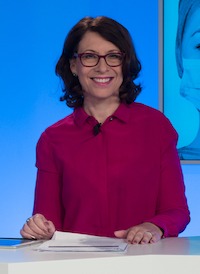
Claire Doole is a former BBC correspondent and international spokeswoman who is passionate about helping people communicate with confidence. Since 2006, she has successfully trained hundreds of professionals in the art of presenting and public speaking, talking to the media, managing communications in a crisis, and writing for the web. In addition, she has coached C-level executives and public figures to give powerful TEDx and TED style talks in Europe and the Middle East. A Swiss and UK national, Claire trains and coaches in French and English.
Claire is also a highly experienced moderator having facilitated panel discussions with government ministers, NGO activists, humanitarians and human rights specialists at major events.

By Claire Doole, www.doolecommunications.com
Are you getting bored of virtual events which go on for hours, with one speaker after another or one panel after another? Often the most gripping moment is seeing how the moderator copes with the technical glitches or closes down the speakers who go over time!
Far too many event organisers have not understood the difference between what goes into a virtual one as opposed to face-to-face. They try to replicate their usual half-day, full-day or two-day event online without thinking about the audience experience.
Having moderated many virtual events in the past 7 months, I firmly believe that organisers will need to work harder as the pandemic continues to retain audience share. Audiences are going to be more selective, only tuning in to events that are well produced, informative and insightful.

By Claire Doole, www.doolecommunications.com
Are you suffering from Zoom fatigue as you rush from one online meeting to another? I am using Zoom as shorthand for all the different platforms that are jostling to sign you up as a customer. In my opinion, Zoom is by far the most interactive and participatory platform, although MS Teams and Webex are catching up.
But the platform is not the biggest challenge to facilitating an online meeting. According to participants in my eWorkshops it is the passive audience, made even worse when people turn off their cameras! Number two, by the way, is lack of non-verbal cues and number three technical glitches.
As a meeting facilitator you have to work hard to get and keep people’s attention. And even harder if you want to break through the virtual divide and get people to engage and participate. In the real world, our brain switches off every 10 minutes if it is not stimulated, so imagine how quickly it tunes out in the virtual world.
The solution is to view facilitating a meeting like running a training session. You have to borrow tools and techniques from training to build engagement and participation.
Here are some of my most effective tools to boost your meeting.

By Claire Doole, www.doolecommunications.com
Until COVID-19 struck, my virtual training consisted of coaching over Skype for clients I couldn't meet face to face.
Today all my training is conducted virtually over numerous other platforms; clients highly rate the experience and learning and development departments are happy to be able to provide this opportunity for their staff's personal development while working remotely.
In the past 6 weeks, I have been running eWorkshops in writing, moderating, storytelling, presenting, media and job interviews and speechwriting.
This is what I have learnt about what makes a successful virtual learning experience.
EWorkshops not webinars
Clients are telling me they much prefer an eWorkshop, which is interactive and participatory rather than watching a YouTube video or attending a webinar, which is usually a PowerPoint Presentation with Q&A.
I know from my attempts to do yoga online that what I really miss is the individual feedback on what I am doing wrong!
With eWorkshops, participants can get that individual feedback just like in the face-to-face training room experience, as long as the group is no more than 8 people.


By Claire Doole, www.doolecommunications.com
Are you, like me, experiencing your own pandemic of webinars and meetings over various videoconference applications such as Zoom (my favourite), WebEx and Microsoft Team Meetings?
Are you that person who now turns off their camera citing connectivity issues so that you can focus on something else rather than actively take part in the videoconference? Or, as a friend related, that person who strategically places themselves with their back to the window or light so that all people see on the call is their silhouette?
It may be because the moderator is just failing to engage you and manage your limited attention span. That is not a criticism. We all have more limited attention spans when we are on these remote calls.
Here are some of my tips and techniques for moderating remotely so you captivate your audience. They are based on my experience as a former TV and radio journalist, panel moderator, public speaker and remote and in person trainer.

By Claire Doole, www.doolecommunications.com
Travel bans, remote working and social distancing are making us all think creatively on how we can continue to interact and get our messages across to as many people as possible.
On Thursday, 19 March, I was involved in what the main newspaper in French-speaking Switzerland, Le Temps, called an " unprecedented online press conference" on the pharmaceutical industry's response to COVID-19.
Working with an excellent team from Acumen public affairs, we brought together the heads of 5 global pharmaceutical companies for a press briefing with media from around the world - with just a week's notice.
Here are my tips and lessons learnt on how to moderate a live studio discussion and press briefing. We are in unprecedented times but the tips apply to any studio setting.









